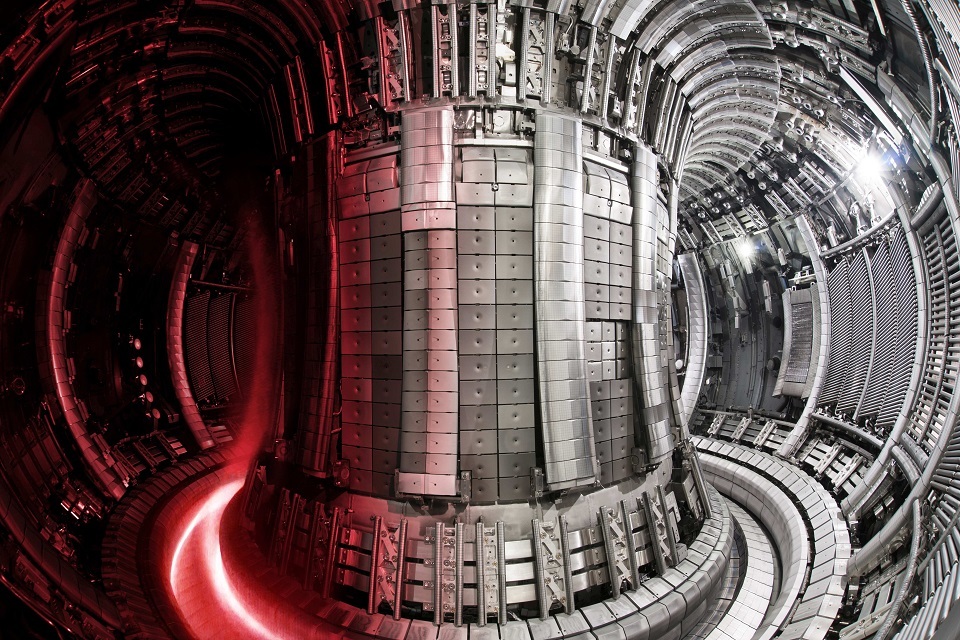The Joint European Torus (JET), one of the world’s largest and most powerful fusion machines, has demonstrated the ability to reliably generate fusion energy, whilst simultaneously setting a world-record in energy output.
These notable accomplishments represent a significant milestone in the field of fusion science and engineering.
In JET’s final deuterium-tritium experiments (DTE3), high fusion power was consistently produced for 5 seconds, resulting in a ground-breaking record of 69 megajoules using a mere 0.2 milligrams of fuel.
JET is a tokamak, a design which uses powerful magnetic fields to confine a plasma in the shape of a doughnut. Most approaches to creating commercial fusion favour the use of two hydrogen variants – deuterium and tritium. When deuterium and tritium fuse together they produce helium and vast amounts of energy, a reaction that will form the basis of future fusion powerplants.
Dr Fernanda Rimini, JET Senior Exploitation Manager, said:
“We can reliably create fusion plasmas using the same fuel mixture to be used by commercial fusion energy powerplants, showcasing the advanced expertise developed over time.”
Professor Ambrogio Fasoli, Programme Manager (CEO) at EUROfusion, said:
“Our successful demonstration of operational scenarios for future fusion machines like ITER and DEMO, validated by the new energy record, instil greater confidence in the development of fusion energy. Beyond setting a new record, we achieved things we’ve never done before and deepened our understanding of fusion physics.”
Dr Emmanuel Joffrin, EUROfusion Tokamak Exploitation Task Force Leader from CEA, said:
“Not only did we demonstrate how to soften the intense heat flowing from the plasma to the exhaust, we also showed in JET how we can get the plasma edge into a stable state thus preventing bursts of energy reaching the wall. Both techniques are intended to protect the integrity of the walls of future machines. This is the first time that we’ve ever been able to test those scenarios in a deuterium-tritium environment.”
Over 300 scientists and engineers from EUROfusion – a consortium of researchers across Europe, contributed to these landmark experiments at the UK Atomic Energy Authority (UKAEA) site in Oxford, showcasing the unparalleled dedication and effectiveness of the international team at JET.
The results solidify JET’s pivotal role in advancing safe, low-carbon, and sustainable fusion energy.
UK Minister for Nuclear and Networks, Andrew Bowie, said:
“JET’s final fusion experiment is a fitting swansong after all the groundbreaking work that has gone into the project since 1983. We are closer to fusion energy than ever before thanks to the international team of scientists and engineers in Oxfordshire.
“The work doesn’t stop here. Our Fusion Futures programme has committed £650 million to invest in research and facilities, cementing the UK’s position as a global fusion hub.”
JET concluded its scientific operations at the end of December 2023.
Professor Sir Ian Chapman, UKAEA CEO, said:
“JET has operated as close to powerplant conditions as is possible with today’s facilities, and its legacy will be pervasive in all future powerplants. It has a critical role in bringing us closer to a safe and sustainable future.”
JET’s research findings have critical implications not only for ITER – a fusion research mega-project being built in the south of France – but also for the UK’s STEP prototype powerplant, Europe’s demonstration powerplant, DEMO, and other global fusion projects, pursuing a future of safe, low-carbon, and sustainable energy.
Dr Pietro Barabaschi, ITER Director-General, said:
“Throughout its lifecycle, JET has been remarkably helpful as a precursor to ITER: in the testing of new materials, in the development of innovative new components, and nowhere more than in the generation of scientific data from Deuterium-Tritium fusion. The results obtained here will directly and positively impact ITER, validating the way forward and enabling us to progress faster toward our performance goals. On a personal note, it has been for me a great privilege having myself been at JET for a few years. There I had the opportunity to learn from many exceptional people.”
JET has been instrumental in advancing fusion energy for over four decades, symbolising international scientific collaboration, engineering excellence, and the commitment to harness the power of fusion energy – the same reactions that fuel the Sun and stars.
JET demonstrated sustained fusion over five seconds at high power and set a world-record in 2021. JET’s first deuterium-tritium experiments took place in 1997.
As it transitions into the next phase of its life cycle for repurposing and decommissioning, a celebration in late February 2024 will honour its founding vision and the collaborative spirit that has driven its success.
The achievements at JET, from the major scientific milestones to the setting of energy records, underscores the facility’s enduring legacy in the evolution of fusion technology.
Its contributions to fusion science and engineering have played a crucial role in accelerating the development of fusion energy, which promises to be a safe, low carbon and sustainable part of the world’s future energy supply.
Check out our press pack for supporting imagery and information.


